Gore Vidal's "Myra Breckinridge" - the movie!
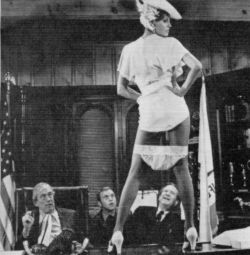 If any film truly deserves the legend 'infamous', then "Myra Breckinridge" must surely be it. Based on a bestselling book by intellectual fruit Gore Vidal, made into a film by a chap called Mike Sarne - whose previous claim to fame was writing and recording the novelty record "Come Outside" with Wendy Richard-Brahms-Fowler - and boasting early appearances from Tom Selleck and Farrah Fawcett, and a post-retirement scene-stealing role played by the one and only Mae West...and also featuring the acerbic film critic Rex Reed in his only acting role, as Myra's alter ego Myron. The film bombed like the proverbial lead zeppelin, and was subsequently disowned by all involved.
If any film truly deserves the legend 'infamous', then "Myra Breckinridge" must surely be it. Based on a bestselling book by intellectual fruit Gore Vidal, made into a film by a chap called Mike Sarne - whose previous claim to fame was writing and recording the novelty record "Come Outside" with Wendy Richard-Brahms-Fowler - and boasting early appearances from Tom Selleck and Farrah Fawcett, and a post-retirement scene-stealing role played by the one and only Mae West...and also featuring the acerbic film critic Rex Reed in his only acting role, as Myra's alter ego Myron. The film bombed like the proverbial lead zeppelin, and was subsequently disowned by all involved.
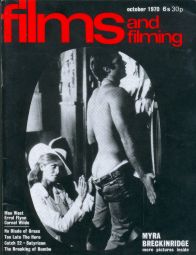 The film was made by Twentieth Century Fox, and was one outstanding example of a league of box office disasters from the Fox studios that later became cult hits: "Bedazzled", "Beyond the Valley of the Dolls", "Entertaining Mr Sloane", "the Rocky Horror Picture Show" and "The Phantom of the Paradise". Anything else? Oh yes, you get to see a man being forcibly butt-fucked by Raquel Welch (in the title role of Myra). It has gone down in history as being 'the worst film ever made'. Quite the reverse - "Myra Breckinridge" is one of the greatest, craziest, funniest films you will ever see. Only someone completely lacking in humour, or not possessing a healthily twisted outlook, can fail to appreciate it! Certainly, it is not entirely faithful to Vidal's original novel, it's disjointed and features some of the strangest editing in a mainstream Hollywood film, but if a film is going to be flawed, it might as well be majestically flawed! They don't make them like this anymore, if indeed they ever did...
The film was made by Twentieth Century Fox, and was one outstanding example of a league of box office disasters from the Fox studios that later became cult hits: "Bedazzled", "Beyond the Valley of the Dolls", "Entertaining Mr Sloane", "the Rocky Horror Picture Show" and "The Phantom of the Paradise". Anything else? Oh yes, you get to see a man being forcibly butt-fucked by Raquel Welch (in the title role of Myra). It has gone down in history as being 'the worst film ever made'. Quite the reverse - "Myra Breckinridge" is one of the greatest, craziest, funniest films you will ever see. Only someone completely lacking in humour, or not possessing a healthily twisted outlook, can fail to appreciate it! Certainly, it is not entirely faithful to Vidal's original novel, it's disjointed and features some of the strangest editing in a mainstream Hollywood film, but if a film is going to be flawed, it might as well be majestically flawed! They don't make them like this anymore, if indeed they ever did...
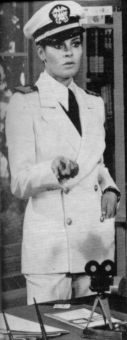 "Myra Breckinridge" begins with Myron Breckinridge, a gay film critic, about to recieve a sex change at the hands of a chain-smoking surgeon (John Carradine). Thus is his alter ego Myra Breckinridge born. Unlike in the book, Myron actually appears alongside Myra in several scenes, the pair existing as a kind of id and ego. Myra dresses like a 1940s film star at all times, and speaks with the melodramatic diction of one as well. Her mission is to infiltrate her way into redneck cowboy Buck Loner's acting academy, get her hands on a fortune that was left to Myron, revive the values of the Golden Age of Hollywood in the era of the permissive society, and destroy men. Along the way, she befriends an all-American couple, all white teeth, impressive hair and full of vacuous comments about being 'normal' ("It's what the majority do"). The male half of this couple, Rusty, is the embodiment of American youth - masculine, dumb, uptight. Rusty becomes Myra's first victim of revenge, via a series of humiliating scenarios which climax in a surreal rape sequence, with Myra dressed in a Stars and Stripes bikini buggering the helpless male! Mae West makes a small but significant contribution to the film as the head of an acting agency with a voracious sexual appetite. Her scenes are full of the sexual innuendos that made her famous and she almost walks off with the film when she performs a funky number called "Ya Gotta Taste All The Fruit" and a proto-rap version of the blues song "Too Hot To Handle" accompanied by black dancers in tuxedos! Classic.
"Myra Breckinridge" begins with Myron Breckinridge, a gay film critic, about to recieve a sex change at the hands of a chain-smoking surgeon (John Carradine). Thus is his alter ego Myra Breckinridge born. Unlike in the book, Myron actually appears alongside Myra in several scenes, the pair existing as a kind of id and ego. Myra dresses like a 1940s film star at all times, and speaks with the melodramatic diction of one as well. Her mission is to infiltrate her way into redneck cowboy Buck Loner's acting academy, get her hands on a fortune that was left to Myron, revive the values of the Golden Age of Hollywood in the era of the permissive society, and destroy men. Along the way, she befriends an all-American couple, all white teeth, impressive hair and full of vacuous comments about being 'normal' ("It's what the majority do"). The male half of this couple, Rusty, is the embodiment of American youth - masculine, dumb, uptight. Rusty becomes Myra's first victim of revenge, via a series of humiliating scenarios which climax in a surreal rape sequence, with Myra dressed in a Stars and Stripes bikini buggering the helpless male! Mae West makes a small but significant contribution to the film as the head of an acting agency with a voracious sexual appetite. Her scenes are full of the sexual innuendos that made her famous and she almost walks off with the film when she performs a funky number called "Ya Gotta Taste All The Fruit" and a proto-rap version of the blues song "Too Hot To Handle" accompanied by black dancers in tuxedos! Classic.
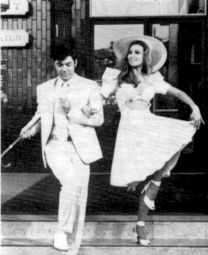 What makes the film is the character of Myra herself. In her own words, "Myra Breckinridge is a dish, and never forget it, you motherfuckers, as the children say nowadays". Writing in the February 1971 issue of Films and Filming, director Mike Sarne described Myra's appeal thus: "...feared for what she says about America, attacked for being too outspoken, hated because she laughs too loud, Myra Breckinridge has lost the chic of New York's cocktail parties and acquired a kind of underground celebrity among the faggot freaks and dope addicts, the rejects from your 'normal' society, the people who love her for being daring and for fighting their battles..."
What makes the film is the character of Myra herself. In her own words, "Myra Breckinridge is a dish, and never forget it, you motherfuckers, as the children say nowadays". Writing in the February 1971 issue of Films and Filming, director Mike Sarne described Myra's appeal thus: "...feared for what she says about America, attacked for being too outspoken, hated because she laughs too loud, Myra Breckinridge has lost the chic of New York's cocktail parties and acquired a kind of underground celebrity among the faggot freaks and dope addicts, the rejects from your 'normal' society, the people who love her for being daring and for fighting their battles..."
Myra herself would probably not see things quite the same way. In Vidal's novel she writes of the hippies and drug addicts, "As a spiritual child of the Forties, I cannot give my imprimatur to this sort of behaviour. The drug taker is a passivist. I am an activist. Yet - to be fair - how can the average person make a meaningful life for himself in an overpopulated world? There is very little of interest for him to do in the way of work, while sex is truly absorbing only for those who possess imagination as well as means. With these young people one has the sense that they know instinctively that there are plenty more where they came from and so why fuss? They'll soon be gone, their places taken by others so closely resembling them that only a mother's eye could tell the difference."
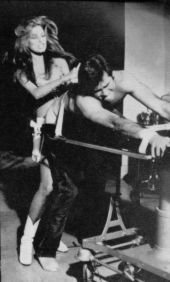 Myra is a ball-breaking women on a mission to emasculate the all-American male and revive the values of the Golden Age of Hollywood (She tells her class, "In the decade between 1935 and 1945, no irrelevant film was made in the United States."!), and it's hard not to love her in spite of herself as she pursues her aims with single-minded passion with her ever-changing wardrobe and assortment of hats and putdowns. As Sarne said of his incarnation of Myra, "You must admit that you would like to have known her, too, with her 'forties hairdo and her hatred of cant and hypocrisy." Of his creation, Vidal insists that "Under that hard-boiled exterior is the heart of a tender man/woman."
It's also easy to see her as a bit of a gay icon. Raquel Welch's portrayal of Myra is a peak moment in her career, and she does a good job of a difficult role. What with her cameos in "The Magic Christian" and "Bedazzled", it would seem Welch's presence in a film is enough to seal its cult status! Sadly, Welch had a sense of humour loss when she starting trying to establish herself as a 'credible' actress and has disowned the film.
Myra is a ball-breaking women on a mission to emasculate the all-American male and revive the values of the Golden Age of Hollywood (She tells her class, "In the decade between 1935 and 1945, no irrelevant film was made in the United States."!), and it's hard not to love her in spite of herself as she pursues her aims with single-minded passion with her ever-changing wardrobe and assortment of hats and putdowns. As Sarne said of his incarnation of Myra, "You must admit that you would like to have known her, too, with her 'forties hairdo and her hatred of cant and hypocrisy." Of his creation, Vidal insists that "Under that hard-boiled exterior is the heart of a tender man/woman."
It's also easy to see her as a bit of a gay icon. Raquel Welch's portrayal of Myra is a peak moment in her career, and she does a good job of a difficult role. What with her cameos in "The Magic Christian" and "Bedazzled", it would seem Welch's presence in a film is enough to seal its cult status! Sadly, Welch had a sense of humour loss when she starting trying to establish herself as a 'credible' actress and has disowned the film.
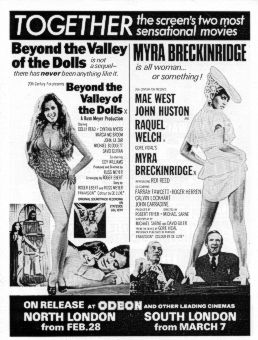 Rex Reed also deserves credit for his character Myron. In the book, Myron is only referred to by Myra in the past tense - Myron is dead, Myra lives - but he plays a larger part in the film, often sharing the screen with Myra. Myron is very much the id to Myra's ego in the film. Reed was (and still is, I believe) a major film critic known for his caustic opinions, and is perfect as Myron. With his slick jet-black hair, blue eyes and smart suits, he is the epitome of the clean cut 1950s bachelor and yet with his waspish quips and sidelong glances, there is something a distinctly cruisy about him. There is a very unusual scene in which, after a row with his alter ego, they make up and Myra goes down on Myron - effectively a narcissistic masturbation sequence! I don't know if Reed acted before or since, but he's one of the best things here!
Rex Reed also deserves credit for his character Myron. In the book, Myron is only referred to by Myra in the past tense - Myron is dead, Myra lives - but he plays a larger part in the film, often sharing the screen with Myra. Myron is very much the id to Myra's ego in the film. Reed was (and still is, I believe) a major film critic known for his caustic opinions, and is perfect as Myron. With his slick jet-black hair, blue eyes and smart suits, he is the epitome of the clean cut 1950s bachelor and yet with his waspish quips and sidelong glances, there is something a distinctly cruisy about him. There is a very unusual scene in which, after a row with his alter ego, they make up and Myra goes down on Myron - effectively a narcissistic masturbation sequence! I don't know if Reed acted before or since, but he's one of the best things here!
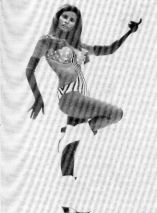 The most striking aspect of "Myra Breckinridge" is the way that clips from vintage films are intecut into the main action. Clips from slapstick comedies, musicals and Westerns appear to provide commentary or juxtaposition on the main action. The American sitcom "Dream On" did this to similar effect with TV clips two decades later. As much of the action takes place at an acting academy, with Myra lecturing on film, legendary scenes such as Busby Berkeley's infamous phallic production numbers and 'cameo appearances' by Laurel and Hardy, Shirley Temple and Marlene Dietrich among others create a reality-confounding hall of mirrors. The cleverest is a blink-and-you'll-miss-it clip of Marilyn Monroe in a swimming pool (from her unfinished last film, "Something's Gotta Give") inserted into a scene at a poolside party. I'm sure Mazza would have approved!
The most striking aspect of "Myra Breckinridge" is the way that clips from vintage films are intecut into the main action. Clips from slapstick comedies, musicals and Westerns appear to provide commentary or juxtaposition on the main action. The American sitcom "Dream On" did this to similar effect with TV clips two decades later. As much of the action takes place at an acting academy, with Myra lecturing on film, legendary scenes such as Busby Berkeley's infamous phallic production numbers and 'cameo appearances' by Laurel and Hardy, Shirley Temple and Marlene Dietrich among others create a reality-confounding hall of mirrors. The cleverest is a blink-and-you'll-miss-it clip of Marilyn Monroe in a swimming pool (from her unfinished last film, "Something's Gotta Give") inserted into a scene at a poolside party. I'm sure Mazza would have approved!
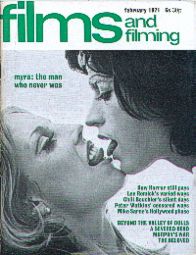 An interesting aside on the film is that Mike Sarne originally considered using a man in adual role playing Myra both as a man and as a woman. He tested six guys before deciding that it wouldn't work. A few pictures of Stanley Glick, one of the actors he tested, as Myra appeared in the February 1971 issue of "Films and Filming" in an article entitled "For Love of Myra". Had a man played Myra, there would have been only one candidate. Myra Breckinridge was a role that Candy Darling, one of Andy Warhol's trio of transvestite superstars ("Women In Revolt", "Trash"), was born to play - and she knew it. In his book, "POPism - the Warhol 60s", Andy wrote:
An interesting aside on the film is that Mike Sarne originally considered using a man in adual role playing Myra both as a man and as a woman. He tested six guys before deciding that it wouldn't work. A few pictures of Stanley Glick, one of the actors he tested, as Myra appeared in the February 1971 issue of "Films and Filming" in an article entitled "For Love of Myra". Had a man played Myra, there would have been only one candidate. Myra Breckinridge was a role that Candy Darling, one of Andy Warhol's trio of transvestite superstars ("Women In Revolt", "Trash"), was born to play - and she knew it. In his book, "POPism - the Warhol 60s", Andy wrote:
"Candy suffered a big disappointment in '69. In fact, she never got over it. As soon as the news that a movie of Myra Breckinridge was going to be made appeared in the trade papers, Candy began writing letters to the studio and the producers and whoever else she could think of, telling them that she'd lived the complete life of Myra and the she knew even more about forties movies than Gore Vidal did. It was true. And they gave the part to Raquel Welch. Poor Candy wrote begging them to please, please reconsider. She knew that if there was ever going to be a role in Hollywood, for a drag queen, this was it."
Apparently, it was the ultimate rejection for Candy Darling, as she felt that Hollywood was the only place that she would fit in.
Gore Vidal has never actually watched the film of his book, although "I do know that despite the iconic presences of Raquel Welch and Mae West, the film was so bad that the book stopped selling for a decade"! Perhaps in an attempt to redress the balance, Vidal wrote a sequel in 1975, Myron. Both books are available in a single volume (published by Abacus in the UK and Penguin in the USA), and although the film is sadly deleted on video, it is frequently shown on Film Four. Every Myron needs a Myra, so do yourself a favour and meet the original Girl Power warrior!
All pictures taken from Films and Filming issues dated October 1970, February 1971 and March 1971. Gore Vidal quotes taken from the Introduction to Myra Breckinridge & Myron published by Abacus (ISBN 0349103658). POPISM - The Warhol '60s by Andy Warhol and Pat Hackett (Hutchinson, 1980) is an essential read in its own right, especially if you enjoy campy gossip about the '60s New York scene!
